House prices plunge in Slovakia
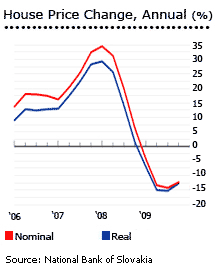
The average dwelling price in Slovakia dropped by 13.4% to €1,342 in Q2 2009 from a year earlier, and Slovakia’s economy contracted more than 5% y-o-y during the first half of 2009. Slovakia’s house price boom had already come to a halt in 2008, as a result of the global crisis.
When adjusted for inflation, the average price actually fell by 15.3%, according to house price figures published jointly by the National Bank of Slovakia (NBS) and the National Association of Real Estate Agencies in Slovakia (NARKS).
The Bratislava region, which covers the capital city, experienced some of the sharpest price falls, at 14.23% (16.2% in real terms) during the year to Q2 2009.
All other regions registered price falls, ranging from 3.2% to 23%.
Small apartments, which had risen in value most, fell furthest:
- Apartments saw the sharpest price falls. The average price of flats fell 15.3% (17.2% in real terms) to €1,372 per sq. m. in the year to Q2 2009.
Smaller units (1 – 3 bedroom units) saw the biggest price falls, with losses ranging from 13.8% to 19.75% during the year to Q2 2009.
Ironically apartments had led Slovakia’s property boom, with average prices rising 87% (70% in real terms) from 2005 to 2008, rising from €635 per sq. m., to €1,080 per sq. m..
Smaller apartments previously experienced the sharpest price increases, with one room units (typically called studio apartments in the US) rising 104% (85% in real terms) to €1,239 per sq. m. in 2008.
- The average price of apartments with five rooms or more, however, rose 5.5% during this recent period. These large apartments had seen relatively small price rises (56%), during the boom period from 2005 to 2008.
- The average price of detached houses fell 9.8% (11.9% in real terms) during the year to Q2 2009, to €1,156 per sq. m.
During the boom, the price of detached houses had only risen 40% during the period from 2005 to 2008 (27% in real terms), rising from €680 per sq. m. to €862 per sq. m..
- The price of villas was down by 0.11% (2.4% real) to €1,777 per sq. m. during the year to Q2 2009.
Villa prices rose only modestly during the property boom, with a 25% price rise from 2005 to 2008 (14% in real terms), rising from €1,130 per sq. m., to €1,288 per sq. m..
Slovakia’s GDP fell by 5.3% during the year to Q2 2009. The economy is expected to stabilize during the second half, and the economic contraction is expected to be around 5% for the entire 2009.
House price falls are not expected to worsen, except in excessively overvalued areas. But rising house prices are unlikely for the next year or so.
The boom: Slovakia’s poorer regions gained most
During the boom Slovakia’s property prices doubled in less than five years , and in some regions price increases were much higher. Strong economic growth, low interest rates, and anticipation of the adoption of the euro pushed house prices up. Prices in poor areas rose fastest, partly because poor regions received more foreign direct investments (FDI).
Residential property prices rose 140% in Trencin, a region in Slovakia’s north-west (120% in real terms) from 2005 to 2008. Trencin has some of Slovakia’s lowest house prices, at €777 per sq. m. in Q2 2009.
Another example: Nitra, where house prices (at €727 per sq. m.) are the country’s lowest, saw house prices double between 2005 and 2008, along with Zilina, Banska Bystrica and Kosice.
Trnava, traditionally the region with the second highest property prices, experienced the smallest price rises from 2005 to 2008, at 55.25%.
AVERAGE RESIDENTIAL PROPERTY PRICES |
||||
CHANGE |
||||
| SLOVAKIA | ||||
| REGIONS | ||||
| Bratislava | ||||
| Trvana | ||||
| Nitra | ||||
| Trencin | ||||
| Zilina | ||||
| Banska Bystrica | ||||
| Kosice | ||||
| Presov | ||||
| PROPERTY TYPE | ||||
| Total flats | ||||
| 1 - room | ||||
| 2 - rooms | ||||
| 3 - rooms | ||||
| 4 - rooms | ||||
| 5 - rooms | ||||
| Total houses | ||||
| Houses | ||||
| Villas | ||||
| Source: National Bank of Slovakia | ||||
The downturn: Bratislava, and the East, hit
Kosice has had the sharpest house price falls this past year, at 23%. Kosice is a mountainous region in the south-easternmost part of Slovakia.
Another province in eastern Slovakia - Presov – saw prices fall 12% (14% in real terms) y-o-y to Q2 2009, falling just less than Bratislava.
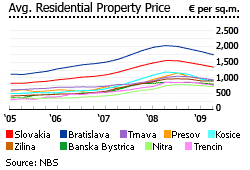

Economic growth powered the house price boom

Strong economic growth, supported by low interest rates, powered Slovakia’s house price boom.
Slovakia’s real GDP growth was 10.4% in 2007, following 8.2% for 2006, 5% for 2005, and 5.5% for 2004. Even in 2008, real GDP growth was an impressive 6.4%, making the Slovak Republic the fastest growing economy within the EU and OECD. From 2002 to 2008, real private sector wages rose by an average of 9.2% annually - an immense rise in purchasing power.
Unemployment dropped to 8.7% in Q4 2008, a significant drop from 19% in 2001.
The budget deficit has been reduced from 10% of GDP in 2000, to just 1.5% of GDP in 2003 and 2.2% of GDP in 2008, still much better than other countries in Europe.
Yet now, the economy is shrinking

Now Slovakia’s economy is expected to shrink by 5% in 2009. The unemployment rate has already risen to 11% in Q2 2009 and is expected to reach 13.6% in 2010. Real wage growth will remain positive, but slow to 4.2% in 2009, and 1.2% in 2010.
To cushion the impact of the recession, the government is doling out subsidies. For instance, state allowances were given to companies that employ redundant employees for at least 60% of their basic wage.
This is quite worrying, because Slovakia’s government needs to continue on its reform path, to keep gaining competitiveness.
The mortgage market is mercifully small
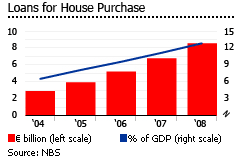
Despite the rapid growth of the mortgage market, outstanding mortgages amounted to just 12.7% of GDP in 2008, one of the lowest mortgage-debt-to-GDP ratios in the EU and far below the EU average of 50% of GDP.
The volume of housing loans to households increased from €2.9 billion in 2004 to €8.5 billion at end-2008, with average growth of 30% annually from 2005 to 2008.
Slovakia’s banks have become very cautious
When other countries adopted the euro, interest rates on mortgages fell dramatically - but not in Slovakia (which adopted the euro in January). By May 2009, the key ECB rate had been reduced to 1%, but Slovakia’s floating loan rate remained more than 4 percentage points higher, at 5.52%.
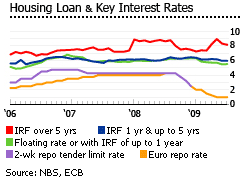
In addition, Slovakia’s long-term fixed loan rates have risen strongly. For instance, here are the average interest rates on housing loans in 2006:
- Floating rate, or fixed for up to 1 year: 5.74%,
- Fixed for 1 - 5 years: 6.03%
- Fixed for 5+ years: 7.07%.
But by July 2009, interest rates on 5 year + fixed housing loans had risen to 8.15%, i.e., more than 2% above the 1-5 year fixed rates (5.96%), or loans fixed for up to a year (5.52%).
Slovakian financial institutions have become extremely cautious. Clearly, they believe interest rates will rise sharply, and they are refusing to absorb the risk.
Little private renting, outside Bratislava
In 1990 mass privatization of flats began in Slovakia, and in 1993 social housing units were sold to tenants at bargain prices. Three-bedroom flats were sold at around €495 to €1,649 - less than 5% of their real market value.
Owner-occupancy rose dramatically, from 49.7% in 1990, to 85% by 2004. The share of co-operative housing fell to 7%, and the share of public rental housing to 5%.
However no private rental sector replaced the previous state system. Only 0.1% of Slovakia’s housing stock is let out by private landlords, mainly concentrated in Bratislava. Strong tenant protection laws discourage landlordism. For instance, landlords must provide the tenant with alternative accommodation in case the rental contract is terminated, regardless of the cause of lease termination.
In 2005, the government decreed the abolition of rent control, effective July 1, 2007. However, the decree was never implemented. Rent deregulation has been postponed repeatedly, as Parliament refuses to deal with the highly sensitive issue.
In Bratislava, yields are quite good
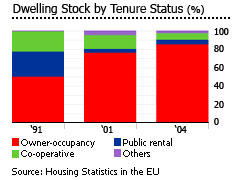
The extremely tight supply of rental units has led to generous gross rental yields on apartments not covered by rent control.
In Stare Mesto, Bratislava’s city centre:
- Yields on 120 sq. m. and 190 sq. m. apartments were around 5.6%, according to Global Property Guide research in July 2009.
- Yields on smaller units of 40 sq.m were even higher, at 6.75%.
In Bratislava’s less upscale districts (Bratislava II & III), gross rental yields were between 5.5% and 7.03%.
The housing stock is an awful mess
In 2005, Slovakia had 309 dwellings per 1,000 inhabitants, well below the EU 15 average of 457 dwellings per 1,000 inhabitants. A large portion of the housing stock needs replacing, especially the poor standard “panelaks” built during the communist regime.
Estimates suggest that around 45,000 to 50,000 new apartments will be needed annually during the coming years. In 2007, only 16,473 new dwellings were completed, one-third in Bratislava.
“This is a very interesting situation,” says Andras Patkai of Ceinvest.sk. “There was a 10-year period after the fall of communism when nothing was built. The gap (in construction) is what is forcing the pace. There is tremendous local demand for new built units,” he adds.
“We see increasing local demand for the West of Bratislava,” says Patkai. “In the Eastern parts there are many ugly Communist-era blocks, which will be the living place for the working class and for new arrivals from the rest of Slovakia.”